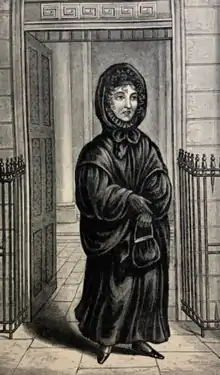Sarah Whitehead
Sarah Whitehead is the reported name of a woman whose ghost is said to haunt the Bank of England; her ghost became known as The Bank Nun.
Sarah Whitehead | |
|---|---|
 Engraving of Whitehead from The New Wonderful Magazine | |
| Known for | Reputedly haunting the Bank of England |
Background
Whitehead's brother, Philip, was employed by the Bank of England from 1797 to 1810.[1] During his employment at the bank, Philip Whitehead "adopted an extravagent lifestyle" and began to speculate on the Stock Market.[1] The directors of the bank allowed him to resign, avoiding dismissal and he set himself up as a stockbroker.[1] Meanwhile evidence came to light, demonstrating that Philip Whitehead had defrauded Robarts & Co. by "forging an acceptance to a Bill".[1] He was charged with forgery in 1811.[2] Then executed on 29 January 1812.[1][3]
The news of her brother's conviction and execution was kept from his sister, Sarah Whitehead, as long as possible.[1] However, upon hearing the news, Whitehead's mental health became unstable and she visited the Bank daily, asking if he was there.[1] This continued until 1818, when the Directors offered Whitehead a financial grant on the condition that she stopped coming to the bank.[1] Whitehead wore black crepe clothing, which was a sign of mourning, and as a result became known as the 'Bank Nun'.[1]
However, there is uncertainty over her identity, since there is no recorded 'Sarah Whitehead' in contemporary records.[4]
Ghost
Whitehead's ghost reputedly haunts the Bank of England, as well as the area on Threadneedle Street nearby.[5]
Legacy
Literature
The story of Whitehead and later on, her ghost, was repeatedly written about and serialised in newspapers in the nineteenth century.[1] The story was re-written as The Lady in Black, or, the Widow and the Wife by James Malcolm Rymer, as penny fiction from 1847-8.[4] Edith Sitwell reimagined Whitehead's story in her book English Eccentrics.[6] The myth of Whitehead's ghost appears in the poem New Year Letter by W H Auden.[4]
Theatre
In 1861 her story was portrayed on stage at the Bower Saloon Theatre on Stangate Street, Westminster Road.[1]
Hauntology
Whitehead's story features in several publications about ghost in London, as well as several events programmes, including: London Ghost Walks;[7] 'Lates' by Bank of England Museum;[8] Reader's Digest List of '20 Most Haunted Places in London'.[9]
Historiography
Whitehead's story has been repeated in many formats, across a large number of years and the story of her ghost needs to considered against the historical background of concerns about forgery in the 1810s.[4] The story of her brother first appears in The Criminal Recorder in 1815.[10] Whitehead's story was first reported in the The Times on 22 February 1828.[4] It was repeated and illustrated in Streetology in 1837.[4] In 1841, a date of death for Whitehead is reported for the first time.[11]
References
- Acres, W. Marston (1931). The Bank of England from Within 1694 - 1900. London: Oxford University Press. p. 368.
- Clark, James (31 August 2007). Haunted London. History Press. ISBN 978-0-7509-5993-3.
- The Digital Panopticon Paul Whitehead b. 1775, Life Archive ID obpt18111030-44-defend374. Version 1.1, consulted 26 January 2019.
- "Rebecca Nesvet, "Miss Whitehead, 'The Bank Nun'" | BRANCH". Retrieved 30 November 2020.
- "London for Ghost Hunters: Five Haunted London Locations". East London History. 16 August 2018. Retrieved 30 November 2020.
- Sitwell, Edith (2003). English Eccentrics. Textbook Publishers. ISBN 978-0-7581-0993-4.
- "The Bank of England - Haunted London". www.london-ghost-tour.com. Retrieved 30 November 2020.
- "Museum late – a spook-tacular soirée!". www.bankofengland.co.uk. Retrieved 30 November 2020.
- "20 Of the most haunted places to visit in London - Reader's Digest". www.readersdigest.co.uk. Retrieved 30 November 2020.
- The Criminal Recorder: Or, Biographical Sketches of Notorious Public Characters, Including Murderers, Traitors, Pirates, Mutineers, Incendiaries ... and Other Noted Persons who Have Suffered the Sentence of the Law for Criminal Offenses ; Embracing a Variety of Curious and Singular Cases, Anecdotes, &c. R. Dowson. 1815.
- Reider, William D. (1841). The New Tablet of Memory; Or, Recorder of Remarkable Events, Compiled and Alphabetically Arranged from the Earliest Period to the Present Time.
External links
- Trial of Paul Whitehead at Old Bailey Online